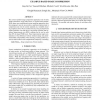Free Online Productivity Tools
i2Speak
i2Symbol
i2OCR
iTex2Img
iWeb2Print
iWeb2Shot
i2Type
iPdf2Split
iPdf2Merge
i2Bopomofo
i2Arabic
i2Style
i2Image
i2PDF
iLatex2Rtf
Sci2ools
86
Voted
ICIP
2010
IEEE
2010
IEEE
Example-based image compression
The current standard image-compression approaches rely on fairly simple predictions, using either block- or wavelet-based methods. While many more sophisticated texture-modeling approaches have been proposed, most do not provide a significant improvement in compression rate over the current standards at a workable encoding complexity level. We re-examine this area, using example-based texture prediction. We find that we can provide consistent and significant improvements over JPEG, reducing the bit rate by more than 20% for many PSNR levels. These improvements require consideration of the differences between residual energy and prediction/residual compressibility when selecting a texture prediction, as well as careful control of the computational complexity in encoding.
Related Content
| Added | 12 Feb 2011 |
| Updated | 12 Feb 2011 |
| Type | Journal |
| Year | 2010 |
| Where | ICIP |
| Authors | Jing-Yu Cui, Saurabh Mathur, Michele Covell, Vivek Kwatra, Mei Han |
Comments (0)

